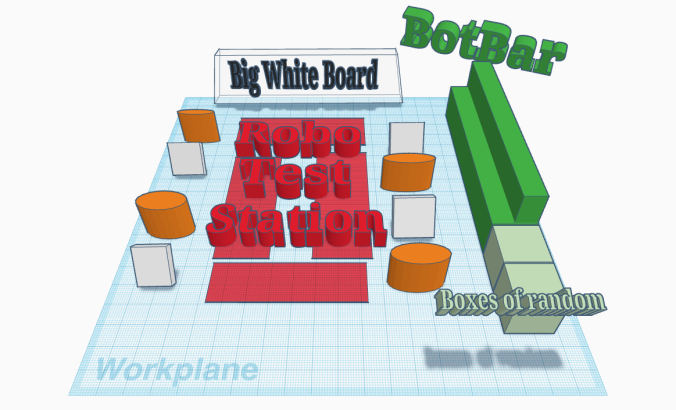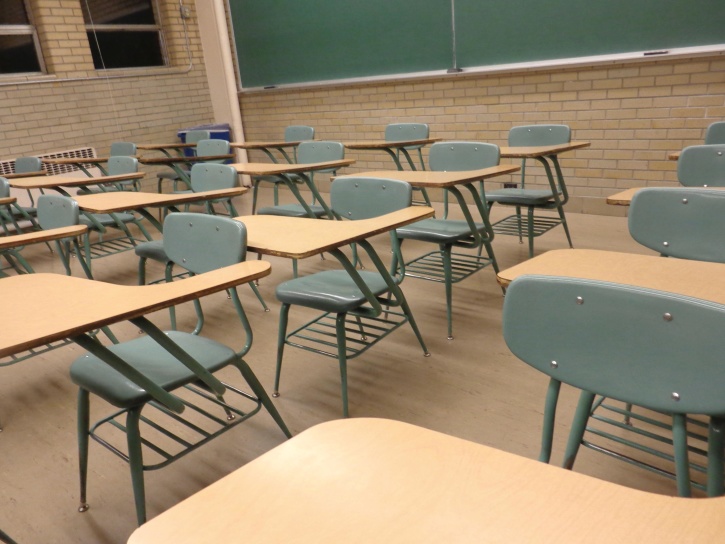In coming up with my learning space redesign, I focused on how to set up a standard 660 sq. ft. classroom to best serve learning with my maker kit, the Lego EV3. I tried to focus on Tedde van Gelderen’s (2010) elements of experience design. You can see a video of van Gelderen explaining the elements here:
The first elements are time and flow. The EV3 lesson plans that I have designed so far begin with an anticipatory set, usually a mission or big question and then move into a mini-lesson. Next, students are quickly moved into smaller collaborative groups. In my design, it was important to have one central focal point, at least to begin the lesson, but it was important that this need is met without sacrificing the freedom of space and movement that students need to do the learning activity. My solution was to put a big whiteboard at the front of the room. Students will be seated in groups around the four team-tables at the edge of the room. This will allow us to begin with the students focused on one point without having to do any significant transition into work time.

The EV3 Learning Space: The red rectangles are the robo test stations. The orange circles represent team tables. The accompanying whiteboards may be moved freely. The bot bar is in green and the boxes of random ar the end of the bot bar.
Each team table has a movable whiteboard as well as a robot test station, a 11 x 4.5 foot strip that is separated with baffling (could be a simple as pool noodle). On one wall is the robo bar, where all of the pieces will be stored. Students will be able to visit the robot bar to get the pieces they need and take them back to their table in a kaboodle. This will minimize jostling for space by the pieces and prevent builds of mass distraction–the fidgets spinners, etc.. To minimize the stress of sorting, I want to sort by the following classes:
- Motors
- Computer and electronics hardware
- Wheels and treads
- Gears
- Wires
- Frame pieces
- Other building pieces, funnel sorted into three categories
- Large
- Medium
- Small
The shelves above the bot bar will be stocked with helpful binders and textbooks that students are welcome to take to their tables to plan their mission.
Van Gelderen’s (2010) next element is participation. This is truly a community building space. Students are at team tables with movable chairs and whiteboards. They can configure their area in a way that works for them, learning through activities which place the emphasis on their solving of problems in order to learn.
Van Gelderen’s (2010) final element is emotion. The room is designed to promote a fun learning environment, not only are students working together to build awesome robots that achieve missions. They have access to two boxes of random. The boxes of random are filled with various thrifted and donated objects that make the missions come to life. Instead of having your robot stop before a line taped to the floor, you can rescue a T. rex from a dollhouse.
Design says a lot about who is driving the lesson and what the role of the student is. This model puts the student in charge, allowing the instructor to provide initial instruction and then move freely to provide immediate feedback to teams as he or she circulates around the room. The biggest challenge in establishing this environment in a current school is getting rid of all of the desks. Space is so important in this environment, the clunky desks have to go! But this would provide middle or high schools students so many valuable lessons as they apply what they are learning in math and science to solving real-world problems.

A traditional middle school classroom is not conducive to this type of learning. Image from Pixnio, CCO license, retrieved from https://pixnio.com/furniture/student-desks-classroom-chairs-tables
This activity has really made me think a lot about the physical space where learning takes place. The more that I explore constructivist models of teaching and learning, the more I am convinced that conventional classroom designs are not conducive to the collaboration and experimentation essential for this type of learning.
Resources
Kjorness, C. 2017, The EV3 Learning Space. Created with Tinkercad.
PPD, (N.D.) Pixnio, Student Desks, Classroom, Chairs, Tables Retrieved from https://pixnio.com/furniture/student-desks-classroom-chairs-tables
van Geldersen, Tedde. “Tedde Van Gelderen on Experience Design.” YouTube, YouTube, 9 Feb. 2010, http://www.youtube.com/watch?v=BB4VFKn7MA4.